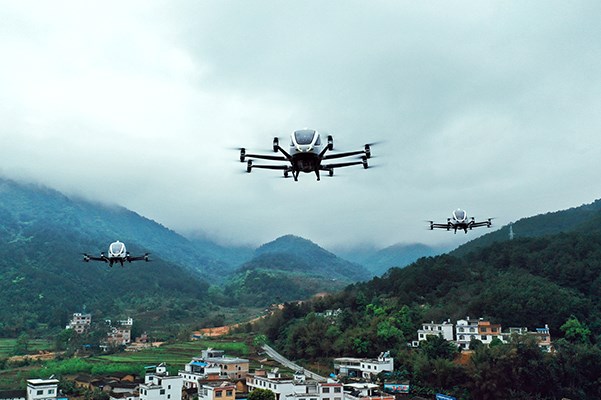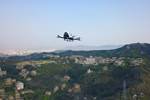CAAC announcement accelerates EHang UAM services
The Civil Aviation Administration of China announced the first Unmanned Civil Aviation Experimental Zones (UCAEZs) for the development of an unmanned civil aviation industry.

EHang 216 passenger-grade AAVs flying in Hezhou, one of the UCAEZs. Photo Credit: EHang
The Civil Aviation Administration of China (CAAC, Guangzhou, China) announced on Oct. 28 the first Unmanned Civil Aviation Experimental Zones (UCAEZs) to solidify China’s global leadership in developing an unmanned civil aviation industry. The list of UCAEZs covers as many as 13 cities including Beijing, Shanghai, Hezhou, Hangzhou, Zigong, Anyang, Nanjing, Tianjin, Yulin, Shenyang, Dongying, Anqing and Ganzhou. In accordance of this announcement, EHang Holdings Ltd. (Guangzhou, China) says it will leverage this new policy to accelerate implementation of its urban air mobility (UAM) pilot city initiative in the UCAEZs.
Under the guidance of the CAAC and the UCAEZs, EHang adds that it wil soon initiate regular UAM operational services. As such, EHang is to gradually expand its business model from an AAV solution provider to a UAM platform operator as planned.
In May 2020, the CAAC issued Guidance on the Construction of Unmanned Civil Aviation Experimental Zones (the Guidance), proposing to organize and mobilize industry forces to provide the UCAEZs with integrated "convenient channels" for airworthiness, operation, air traffic control and business licensing. The Guidance also promotes active cooperation with the local governments of the UCAEZs in airspace coordination, and encourages unmanned aviation enterprises and institutions to make use of existing infrastructure to implement operating practices.
With the implementation of UCAEZs in China, EHang will continue to accelerate the regular operations of its AAV technology solutions for various practical use cases including passenger transportation, aerial sightseeing, air logistics, aerial firefighting, emergency rescue, medical transportation and so on.
Related Content
-
Materials & Processes: Resin matrices for composites
The matrix binds the fiber reinforcement, gives the composite component its shape and determines its surface quality. A composite matrix may be a polymer, ceramic, metal or carbon. Here’s a guide to selection.
-
Materials & Processes: Fibers for composites
The structural properties of composite materials are derived primarily from the fiber reinforcement. Fiber types, their manufacture, their uses and the end-market applications in which they find most use are described.
-
A new era for ceramic matrix composites
CMC is expanding, with new fiber production in Europe, faster processes and higher temperature materials enabling applications for industry, hypersonics and New Space.













